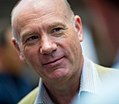
World Toilet Day (WTD) is an official United Nations international observance day on 19 November to inspire action to tackle the global sanitation crisis. Worldwide, 4.2 billion people live without "safely managed sanitation" and around 673 million people practice open defecation. Sustainable Development Goal 6 aims to "Ensure availability and sustainable management of water and sanitation for all". In particular, target 6.2 is to "End open defecation and provide access to sanitation and hygiene". When the Sustainable Development Goals Report 2020 was published, United Nations Secretary-General António Guterres said, "Today, Sustainable Development Goal 6 is badly off track" and it "is hindering progress on the 2030 Agenda, the realization of human rights and the achievement of peace and security around the world".

World Water Day is an annual United Nations (UN) observance day held on 22 March that highlights the importance of fresh water. The day is used to advocate for the sustainable management of freshwater resources. The theme of each year focuses on topics relevant to clean water, sanitation and hygiene (WASH), which is in line with the targets of Sustainable Development Goal 6. The UN World Water Development Report (WWDR) is released each year around World Water Day.

The Decade of Education for Sustainable Development (DESD) 2005–2014 was an Education for Sustainable Development (ESD) initiative of the United Nations. The Decade was delivered by UNESCO as lead agency, and gave rise to Regional Centres of Expertise (RCE) networks, and the GUPES universities' partnership. The launch of the United Nations Decade of Education for Sustainable Development started a global movement to reorient education to address the challenges of sustainable development. It was the first UN Decade to establish a global monitoring and evaluation process and expert group. Building on the achievement of the Decade, stated in the Aichi-Nagoya Declaration on ESD, UNESCO endorsed the Global Action Programme on ESD (GAP) in the 37th session of its General Conference. Acknowledged by UN general assembly Resolution A/RES/69/211 and launched at the UNESCO World Conference on ESD in 2014, the GAP aims to scale-up actions and good practices. UNESCO has a major role, along with its partners, in bringing about key achievements to ensure the principles of ESD are promoted through formal, non-formal and informal education.
The UNESCO World Water Assessment Programme was founded in 2000 in response to a call from the UN Commission on Sustainable Development (CSD) to produce a UN system-wide periodic global overview of the status, use and management of freshwater resources. To meet this challenge, WWAP coordinates the work of 31 UN-Water members and international partners, under the umbrella mechanism of UN-Water, in the production of the World Water Development Report (WWDR). The WWDR is the UN flagship report on water issues; it is a comprehensive review, released every year with a different focus on different strategic water issues, that gives an overall picture of the state, use and management of the world’s freshwater resources and aims to provide decision-makers with tools to formulate and implement sustainable water policies.

The United Nations created 17 world development goals call the Sustainable Development Goals (SDGs). They were created in 2016 with the aim of "peace and prosperity for people and the planet, now and into the future."
The Water Supply and Sanitation Collaborative Council (WSSCC) was a United Nations-hosted organization contributing to Sustainable Development Goal 6, Target 6.2 on sanitation and hygiene. It was established in 1990 and closed at the end of 2020. WSSCC advocated for improved sanitation and hygiene, with a focus on the needs of women, girls and people in vulnerable situations.
The United Nations Interagency Task Force on the Prevention and Control of Non-communicable Diseases (UNIATF), hereafter referred to as the Task Force, was established by the United Nations Secretary-General in 2013. Non-communicable diseases (NCDs), also known as chronic diseases, include cardiovascular diseases, cancers, chronic respiratory diseases and diabetes. The role of the Task Force is to bring relevant actors from across the United Nations (UN) system and national governments together to develop whole-of-government, whole-of-society approaches for the prevention and control of NCDs. Following the establishment of the 2030 Agenda for Sustainable Development in 2015, the Task Force's scope of work was expanded to include “NCD related Sustainable Development Goals (SDGs)” such as addressing mental health conditions, violence, injuries, nutrition and environmental issues that contribute to the global burden of NCDs. The Task Force promotes multisectoral action for the prevention and control of NCDs, supports countries to achieve the Sustainable Development Goals (SDGs) and supports countries to move towards Universal Health Coverage (UHC). The work of the Task Force includes implementing the Global Joint Programme to conduct investment cases, coordinating interagency joint programmes and facilitating thematic working groups. The World Health Organization acts as a Secretariat for the Task Force.

Established in 1992, the Major Group for Children and Youth is the United Nations General Assembly mandated, official, formal and self-organised space for children and youth to contribute to and engage in certain intergovernmental and allied policy processes at the United Nations.
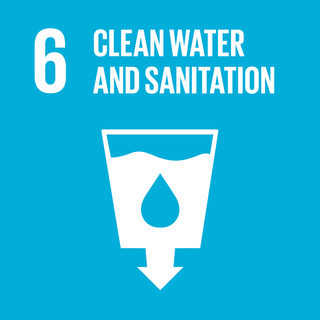
Sustainable Development Goal 6 is about "clean water and sanitation for all". It is one of the 17 Sustainable Development Goals established by the United Nations General Assembly in 2023. According to the United Nations, the goal is to: "Ensure availability and sustainable management of water and sanitation for all." The goal has eight targets to be achieved by 2030. Progress toward the targets will be measured by using eleven indicators.
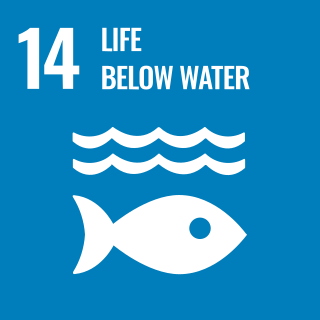
Sustainable Development Goal 14 is about "Life below water" and is one of the 17 Sustainable Development Goals established by the United Nations in 2015. The official wording is to "Conserve and sustainably use the oceans, seas and marine resources for sustainable development". The Goal has ten targets to be achieved by 2030. Progress towards each target is being measured with one indicator each.
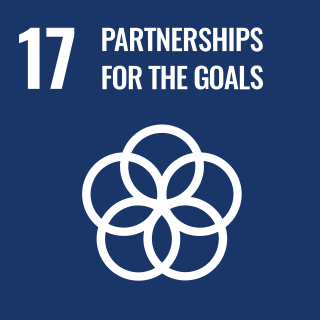
Sustainable Development Goal 17 is about "partnerships for the goals." One of the 17 Sustainable Development Goals established by the United Nations in 2015, the official wording is: "Strengthen the means of implementation and revitalize the global partnership for sustainable development". SDG 17 refers to the need for the nonhegemonic and fair cross sector and cross country collaborations in pursuit of all the goals by the year 2030. It is a call for countries to align policies.
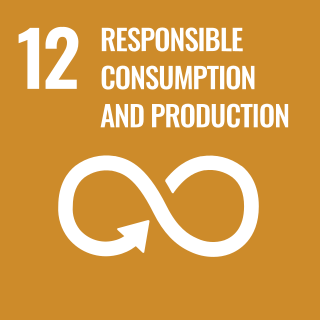
Sustainable Development Goal 12, titled "responsible consumption and production", is one of the 17 Sustainable Development Goals established by the United Nations in 2015. The official wording of SDG 12 is "Ensure sustainable consumption and production patterns". SDG 12 is meant to ensure good use of resources, improve energy efficiency and sustainable infrastructure, provide access to basic services, create green and decent jobs, and ensure a better quality of life for all. SDG 12 has 11 targets to be achieved by at least 2030, and progress towards the targets is measured using 13 indicators.

Sustainable Development Goal 11, titled "sustainable cities and communities", is one of 17 Sustainable Development Goals established by the United Nations General Assembly in 2015. The official mission of SDG 11 is to "Make cities inclusive, safe, resilient and sustainable". The 17 SDGs take into account that action in one area will affect outcomes in other areas as well, and that development must balance social, economic and environmental sustainability.

Sustainable Development Goal 3, regarding "Good Health and Well-being", is one of the 17 Sustainable Development Goals established by the United Nations in 2015. The official wording is: "To ensure healthy lives and promote well-being for all at all ages." The targets of SDG 3 focus on various aspects of healthy life and healthy lifestyle. Progress towards the targets is measured using twenty-one indicators.

Sustainable Development Goal 2 aims to achieve "zero hunger". It is one of the 17 Sustainable Development Goals established by the United Nations in 2015. The official wording is: "End hunger, achieve food security and improved nutrition and promote sustainable agriculture". SDG 2 highlights the "complex inter-linkages between food security, nutrition, rural transformation and sustainable agriculture". According to the United Nations, there are around 690 million people who are hungry, which accounts for slightly less than 10 percent of the world population. One in every nine people goes to bed hungry each night, including 20 million people currently at risk of famine in South Sudan, Somalia, Yemen and Nigeria.
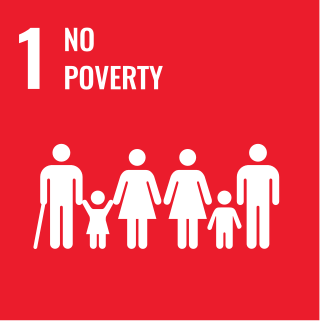
Sustainable Development Goal 1, one of the 17 Sustainable Development Goals established by the United Nations in 2015, calls for the end of poverty in all forms. The official wording is: "No Poverty". Member countries have pledged to "Leave No One Behind": underlying the goal is a "powerful commitment to leave no one behind and to reach those farthest behind first".

The "Sustainable Development Goals and Australia" describe how Australia participates in the Sustainable Development Goals (SDGs) process. The SDGs are a collection of 17 global goals designed to be a "blueprint to achieve a better and more sustainable future for all". The SDGs, set in 2015 by the United Nations General Assembly and intended to be achieved by the year 2030, are part of a UN Resolution called "The 2030 Agenda". The targets and indicators for the SDGs are included in the UN Resolution adopted by the General Assembly two years later on 6 July 2017.

The Sustainable Development Goals and Ghana describes how the Sustainable Development Goals are being implemented in Ghana. The SDGs are also known as the 2030 Agenda for Sustainable Development and are a set of seventeen global goals for 169 specific areas developed by the United Nations. The Sustainable Development Goals were formed in Rio de Janeiro in 2012 at the UN Conference on Sustainable Development. Its aimed to produce a set of universal goals claimed to meet the urgent environmental, economic and political problems facing the world.

Sustainable Development Goals and Nigeria is about how Nigeria is implementing the Sustainable Development Goals within the thirty-six states and its Federal Capital Territory (FCT). The Sustainable Development Goals (SDGs) consist of seventeen global goals designed as a "blueprint to achieve a better and more sustainable future for all". Each of the 17 goals is expected to be achieved by 2030 in every country around the world.
Sustainable Development Goals and Lebanon explains major contributions launched in Lebanon towards the advancement of the Sustainable Development Goals SDGs and the 2030 agenda.







